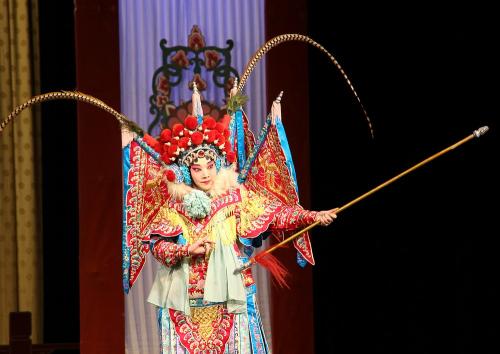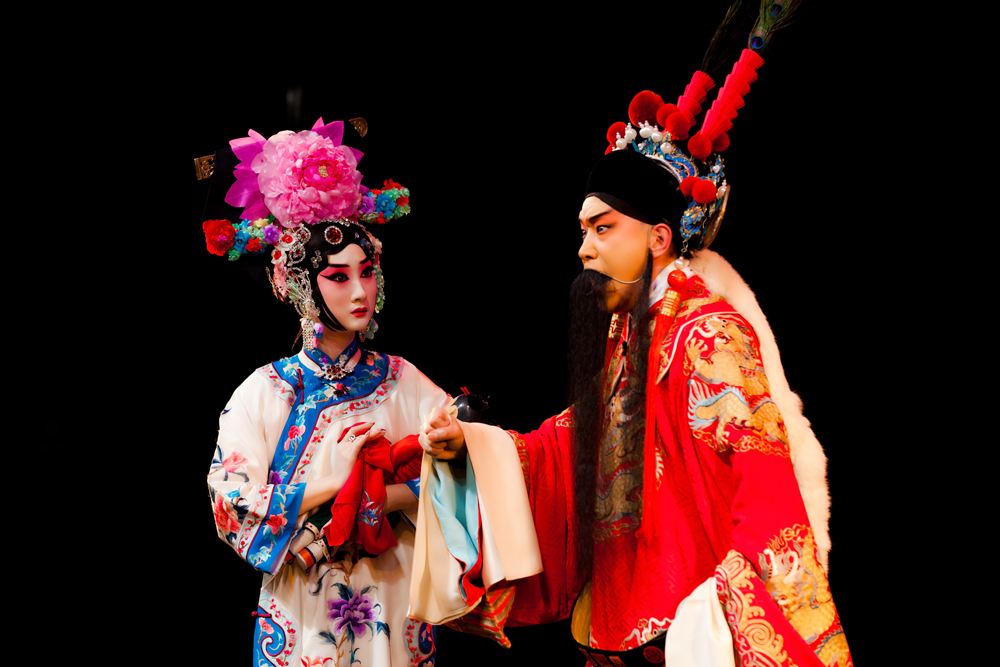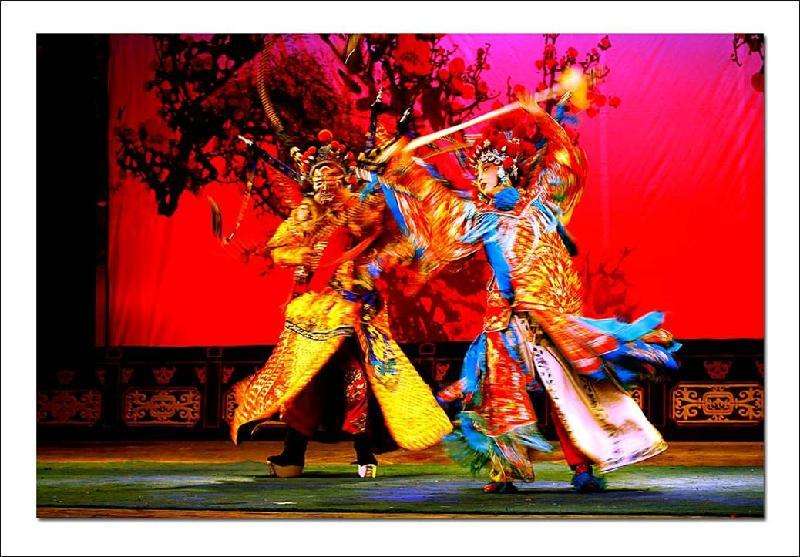Peking Opera and Local Operas
10 min readMany local operas gradually arose in the late Ming and early Qing dynasties.
Through continuously absorbing new art elements in their evolution, each opera has its unique artistic form. Peking opera and several major local operas are described here with a special eye on their origins and artistic features.
Peking opera. In 1790, the prestigious Sanqing Opera Troupe popular in Jiangnan was invited to Beijing to perform for the celebration of Emperor Qianlong’s birthday. Sanqing Troupe was one of Anhui opera troupes which were highly praised in the south in the early Qing dynasty. Following that, many other Anhui opera troupes came to Beijing one after another, among which Sixi Troupe, Chuntai Troupe and Hechun Troupe were the most famous ones. Together with Sanging they were called “Four Great Anhui Opera Troupes”. After 1828, some Han opera performers came to Beijing. Han opera was a local opera prevailed in Hubei. Its tune_consisted of xipi and erhuang, but with more focus on xipi.

Anhui opera and Han opera learned from each other in tunes and performing styles. After Han opera performers came to Beijing, they often performed jointlywith Anhui troupes, some even became leading members of Anhui troupe, such as Yu Sansheng. After mutual absorption for a while and drawing elements from Kunqu, Yiqiang, and Qinqiang, the two opera forms gradually evolved into Peking opera plus Beijing accent in the tune. The official formation of Peking opera began roughly after 1840 when a variety of tunes and its language features took initial shape and new changes in the roles also arose. There had already been some repertoires with the characteristics of Peking opera and the first generation of performers emerged.
The representative of this period was Cheng Changgeng. He made great efforts to combine Han and Anhui operas and reform and improve the elements of Kunqu opera it Peking opera. After its formation, Peking opera gradually spreaded from Beijing to all over the country, and finally became China’s national opera.
Kunqu opera. Kunqu opera is one of the oldest forms of Chinese traditional opera. As early as the end of the 13th century, it was already popular around Kunshan, Jiangsu. During the reign of Emperor Jiajing and Emperor Longqing of the Ming dynasty, some musicians such as Wei Liangfu, based on the musical traditions of operas in the South and the North, took in the features and strengths of the tunes such as nanxi, and created a new delicate and soft tune—shuimo tune. In accompaniment, besides stringed instruments, sheng, xiao(a vertical bamboo flute), pipe, flute and other musical instruments were also added. This opera form spreadedquickly, and later became Kunqu opera. Kunqu opera has many repertoire, and its text is elegant with very high literature value; many of its song lyrics are actually graceful in restrained or sad verses. The Ming and Qing dynasties witnessed the mostprolific works of Kunqu writers. Supported by a complete performance system and tune system, it is unique in pronunciation and articulation, and strictly abides by lexical norms and principals. The tunes of Kunqu opera are mellow, melodious and lyrical, and its singing and dancing movements are combined in a subtle and harmonious way.
Qinqiang. Also known as “Luantan”, Qinqiang is one of China’s oldest surviving operas. Treasured as the source of a great variety of operas, it is the origin of Peking opera, Henan opera, Shanxi opera and Hebei bangzi(Hebei clapper opera).
Qinqiang saw its further evolution in China’s east and west. In the east, it has developed into Bangzi in Sichuan, while in the west, it has grown into Shanxi opera, Henan opera and Bangzi in Shanxi, Henan and Hebei provinces respectively. Qinqiang’s aria is featured with “Banlu”and “Caiqiang”, each of which has Huan yin(“joyous tune”) and Ku yin(“sad tune”). Ku yin could best represent the features of Qinqian as it is sonorous, bold, passionate and touching to show grief, yearning, and sorrowfulness. The characters of Xusheng (a male role with whiskers), Qingyi(young elegant female with strict moral and virtuous codes), Laosheng(a middle-aged or old man), Laodan(elderly woman) and Hualian(a male role with painted face) in Qinqiangare all stressing the importance of singing skill. Qinqiang performances before the Qing dynasty were also known as Xi’ an Luantan. Its qupai (named tune or labeled melody) mainly consists of string instruments and the suona horn, often accompanied by erxian(a two-string fiddle). The stringed instrumentalists who act as accompanists in traditional opera play an important role in Qinqiang troupes. They often sit in the middle of the back stage. Qinqiang prevails in northwestern China, namely Shaanxi, Gansu, Qinghai, Ningxia, and Tibet.
Sichuan opera. Sichuan opera took shape by integrating high-pitched tune, Kun tune, Huqin tune and weak tune together with Sichuan’s folk lantern opera. From the end of Ming to the mid-Qing dynasties, as migrants moved into Sichuan, many opera troupes also came to the province. By taking in Sichuan dialects, folk customs, folk music, dances, rap ballads and folk songs, different tunes were gradually merged during stage performance in language, performance, music and stage arts, and gave rise to a new genre–“Sichuan drama”later renamed as “Sichuan opera”. The repertoire of Sichuan opera is rich, with hundreds of kinds commonly performed on the stage. High-pitched tune is the major form of singing of Sichuan opera which haa rich array of qupai with graceful singing tunes of strong local characteristics.

The assistant tunes of Sichuan opera include leading tune, associate tune, chorus, accompany singing and ensemble. Sichuan opera features vivid and humorous language which is of pronounced local flavor and rich taste of life. It gets richer in evolution as such acting and stunts as face change, knife hiding, fire ring jumping and eye kicking among many others are developed. Sichuan opera prevails mainly in Sichuan, Yunnan and Guizhou.
Hebei Bangzi. There were many alternative names for Hebei Bangzi. In Hebei province, it was called Zhili Bangzi, Hebei Bangzi, Qinqiang, or Bangziqiang; people from outside Hebei called it Jingbang, Dibangzi or Fandiao… It was also referred to as Wei Bangzi or Shanxi Bangzi. In 1952, it was officially named as Hebei Bangzi.
During the reign of Emperor Daoguang of the Qing dynasty, Bangzi operas from Shanxi and Shaanxi were introduced into Hebei; and in the the long course of performance, they experienced constant reforms and changes in accordance with the local language, customs, fun, and hobbies, eventually resulting in the birth of Hebei Bangzi. The singing mode of Hebei Bangzi belongs to the style of Banqiang, with high pitch an strong emotion, which is suitable for expressing feelings of excitement and anger. Stress is laid on special singing skills such as on the “palate cough”,”venting”,”smashing and tamping”. The main musical accompaniment of traditional Hebei Bangziis banhu(a bowed stromged instrument with a thin wooden soundboard), with flute as secondary accompaniment. Hebei Bangzi is popular not only in the rural areas of Beijing, Tianjin, Hebei, but also in Shandong, Henan, Heilongjiang, Jilin, Liaoning, Inner Mongolia and other places.
Cantonese opera. In the late Ming and early Qing dynasties, local troupes arose in Guangdong. Their singing, then called “Cantonese tune”, was characterized by its singing style with one singer harmonized by several accompanying singers. During the reign of Emperor Jiaqing and Emperor Daoguang of the Qing dynasty, local troupesadopted bangzi as their main singing style and gradually formed a mature opera-Cantonese opera. Cantonese opera adopts bangzi and erhuang as its main singing style and retains the features of Kunshan tune and Yiyang tune while absorbing Guangdong rap ballads such as Nanyin, Yueou, Muyu, Longzhou and Banyan, and folk tunes.

Guangzhou dialect is adopted in all the singing and speaking of Cantonese opera, so it is also known as “Guangdong opera”or “Guangfu show”. It uses a great varietyof musical instruments. In addition to traditional musical instruments, many western musical instruments are also adopted, such as violin, cello, saxophone and otherinstruments of mediant and bass. The martial performance of Cantonese opera is featured by straightforwardness and simplicity; many of its actors and actresses are great performers of such stunts as one-foot performance, somersault, cable slipping, hair swinging, beard kongfu, and so on. Its martial arts performances are based on”southern school martial arts”, including the bold target, shaolin boxing, as well as the difficult chair stunt and high-platform stunt.
Shanxi opera. Also called Shanxi Bangzi or Zhonglu Bangzi, Shanxi opera is one of the four great bangzi operas in Shanxi, the other three are Puzhou Bangzi, BeiluBangzi and Shangdang Bangzi. It originated from Puzhou Bangzi and prevailed duringthe reign of Emperor Xianfeng and Emperor Tongzhi of the Qing dynasty. Actors then were mostly from Puzhou, who recited in Puzhou local dialect. Later, Shanxi opera gradually formed its own artistic style by absorbing such folk art in central Shanxprovince as yongge(or Rice Sprout Song) and changing Puzhou opera’s flute into huqin (Chinese fiddle) as their accompanying instrument. The melody of Shanxi opera isgentle, smooth, beautiful and mellow, and its reciting is clear with rich country flavor from central Shanxi.
The singing and performing skills of Shanxi opera are characterized by the excitement and roughness of bangzi on one hand, and smoothness and fineness on the other. There are many unique stunts in Shanxi opera, such as pheasant feather tail stunt, hat wing stunt, chair stunt, whip stunt, hair stunt, bowl-playing, headscarf-playing and plait-playing. Shanxi opera prevails in central and northern Shanxi, most of the Inner Mongolia region, and even as far as Hebei, Shaanxi, and Gansu provinces.
Henan opera. Also known as Henan bangzi or Henan high-pitch, Henan opera is one of the major opera forms in Henan province. It belongs to bangzi system in tune and is divided into four schools in music:”Xiangfu tone”in areas around Kaifeng,
“Yudong tone”or “Donglu tone”in areas around Shangqiu,”Yuxi tone “or “Xifu tone’and “Kaoshanhuang”in areas around Luoyang and “Shahe tone”or “Local bangzi”in areas alongside the Shahe River in southeast of Henan province. During the period of Republic of China, Henan opera performers such as Chang Xiangyu and others, based on Yuxi tone, formed a new style by absorbing the singing features of Yudong tone and drawing on certain tunes, repertoire and performance of Zhuizi(a popular form of narrative singing, accompanied by a bowed lute called zhuihu), Dagu(a genre ofChinese story-telling, usually accompanied by a small drum), and Peking opera.
Henan opera has always been known for its strength in singing. Its song lyrics which are mostly seven-word or ten-word lines, are easy to understand. The singing is smooth with clear rhythm and the tune structure is the variation style of rhythm.
with relatively complete music programs. The musical instruments for accompaniment differ in civil and martial scenes, with erxian(two-string fiddle), sanxian(three-string fiddle) and yueqin for civil scene, while erxian, due to its excessive sharp tone, was replaced by banhu later, and bangu(drum for marking time), tanggu (ceremonial hall drum), large gongs, small gongs and clapper usually for martial scene. Henan opera prevails in almost all parts of China.
Huangmei opera. Huangmei opera is a major local opera in Anhui province. In the late 18 th century,a small folk drama took shape in the area ad jacent to Anhui, Hubei, and Jiangxi provinces. One branch of the drama gradually moved east to Anqing area centering around Huaining county, Anhui province. Integrating with folk art there, it was called “Huai tune”or “Huai tone”, which is predecessor of Huangmei opera today. From 1911 Revolution to 1949, Huangmei opera developed from rural areas onto city stage and gradually became professionalized.
After beginning to perform in cities, Huangmei opera saw initial transformationin its traditional singing style. It reduced the virtual sound words to make it fast, smooth, and easy to understand, abolished accompanying singing, adopted huqin as accompanying instrument and drew upon the stylized movements of Peking opera and other operas to enrich the means of expression. Huangmei opera consists mainly of two kinds of arias: coloratura (huaqiang) and flat tune (pingci). Coloratura belongs to qupai style and is made up of the playlets that were based mostly on short stories. It enjoys the taste of real life just as folk songs. Flat tune belong tobanqiang style and is traced from the tunes of high-pitched tune, fiddle ballad, Anhui tone and Peking opera, and is the major arias of script plays. The classic repertoire of Huangmei opera includes Heavenly Match, Female Duke and Cowherd and the Girl Weaver. There are Huangmei opera troupes in many places, such as Hubei, Jiangxi, Fujian, Zhejiang, Jiangsu, Taiwan and Hong Kong.
Yue opera. Also known as Shaoxing opera, it was derived from a kind of story-singing popular in Shengxian county, Zhejiang province. It began to be performed on rural stage in the spring of 1906 and was called “Little Song Troupe”,”Didu Troupe”or “Shaoxing Drama”. As the performers at the very beginning were basically boys from countryside, it was also known as “male troupe”. In September 1925, Shanghai The News first used “Shaoxing opera”as the show’s name in advertising. In October 1942, Yuan Xuefen,a performer of Yue opera, took stage play as the example and reformed Yue opera by creating new repertoire, adapting traditional ones, establishing script system and abolishing the practice of improvisational performance around the given plot lines.
In performance, Yue opera learned skills from stage play and film on one hand, and drew upon the graceful dancing and stylized movements from Kunqu and Peking opera on the other. Thus, it gradually formed the style combining both freehand and realistic features. On stage art, reforms were adopted in the use of three-dimensional scenery, colorful lighting, sound, paint make-up, and the clothing colors and styles. Yue opera put on a new face after the reform and created a great number of exquisite works of art, such as Butterfly Lovers, Romance of the West Chamber, Dream of Red Mansion and Mrs. Xianglin. Yue opera not only has great influence all over the country, but also won international reputation.
The opera forms mentioned above are some of the main operas in China. In addition, there are many other local operas, such as Han opera, Puxian drama, Hunan opera, Guangxi opera and Chu opera, which all have distinctive artistic charms.
Statistics show that there are a total of over 400 kinds of local operas in China, excluding those small ones accepted in a narrow scope.








